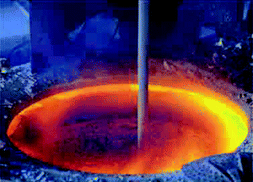Secondary zinc and lead production is addressed as one of the potential sources of polychlorinated dibenzo-p-dioxins and dibenzofurans (PCDD/Fs) and dioxin-like polychlorinated biphenyls (dioxin-like PCBs) due to the impurity of the raw material. However, the release inventory of PCDD/Fs and dioxin-like PCBs is very scarce for these secondary nonferrous metallurgies. This study selected typical secondary zinc and lead plants to investigate the emissions of PCDD/Fs and dioxin-like PCBs released from such plants in China. The toxic equivalent quantity (TEQ) emission factor of PCDD/Fs and dioxin-like PCBs released into the environment is higher for secondary zinc production, at 52 298.02 ng TEQ ton−1 than for secondary lead production, at 646.05 ng TEQ ton−1. The most abundant congeners of PCDD/Fs are 2,3,4,7,8-PeCDF and 1,2,3,4,6,7,8-HpCDF for the secondary zinc and lead metallurgies, respectively. The most abundant congener of dioxin-like PCBs in the samples collected from both metallurgies is CB-126 . According to the distribution of PCDD/Fs (PCDF/PCDD ≫ 1) and the dominant contribution of higher chlorinated congeners, the de novo synthesis is assumed to be the main formation pathway of PCDD/Fs in the secondary zinc metallurgies. For the secondary lead metallurgies, the role of precursor formation is also very important. Based on the emission factor and production level, the total estimated emission amounts of PCDD/Fs and dioxin-like PCBs in both stack gas and fly ash released into the environment from secondary zinc and lead production is estimated to be at least 2.76 and 0.42 g TEQ yr−1, respectively. The dioxin-like PCBs contribute 2.8% and 0.6% of the total emission from secondary zinc and lead plants, respectively.


 Please wait while we load your content...
Please wait while we load your content...